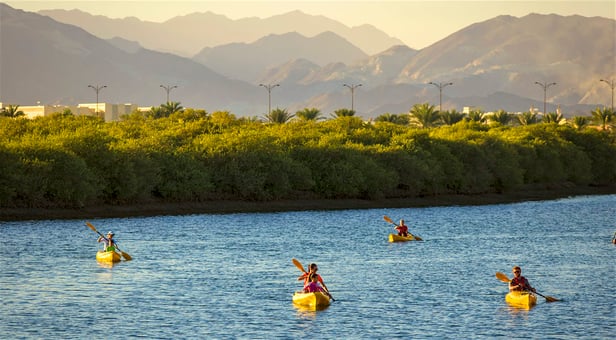The UAE is not exactly famous for its forests and abundant wildlife. Which is why Kalba, Sharjah’s southernmost east coast enclave, is such a special place. Its majestic mangroves and rugged mountains are vital habitats for rare birds, endangered turtles and other creatures, making them a paradise for nature lovers and wildlife watchers.
Exploring a mangrove forest
A key feature is the Al Qurm Nature Reserve, a vast emerald forest of mangroves (‘qurm’ in Arabic) that hugs two branches of winding tidal creek for some 7km. The area is a top bird breeding ground as well as a stopover on the avian flyway between Eastern Europe and Africa.
There’s something quite disorienting about so much water and green trees in the middle of the desert. You can easily take it all in from the Kalba Bridge near the mouth of the creek. But to truly absorb the beauty of this serene landscape, take a kayaking trip such as those offered by Absolute Adventures. Gliding gently through the still channel is like a meditation, the silence interrupted only by the paddle softly dipping into the water and the occasional bird screeching or swooping down to snag a crab.
With a lot of luck, you might even spot Al Qurm’s most famous feathered denizen, the ultra-rare Arabian collared kingfisher, a magnificent bird with a white-chest and bright turquoise top coat. Virtually endemic to Kalba, it nests in natural holes in mangrove trunks and branches and snacks mostly on crabs that are exposed in the mudflats during low tide. Another rare species breeding here is the Sykes’ warbler, while sooty gulls and Indian pond herons are seasonal visitors. Meanwhile, sightings of terns, gulls, herons, sandpipers and sanderlings are decidedly more common.

Saving the mangroves
While paddling along, take time to marvel at the mangroves themselves. These trees are tough! They thrive in salty coastal water, get pushed and pulled by the daily tides and are mercilessly scorched by the sun. To help them take in oxygen, they grow air-breathing tubes whose tips are exposed during low tide. Their twisted root network is a jungle gym for juvenile fish, while their dense foliage provides shelter for nesting birds. And if that’s not enough, they also protect the coastline from storm damage and erosion. In other words, mangroves deserve our respect.
But for a long time, instead of love, the Kalba mangroves got a drubbing from human intrusion, most notably fishing, beach-driving and beach-camping. In 2012, the Sharjah government put on the breaks to save this sensitive ecosystem by making it off-limits to the public and kicking off its rehabilitation. A royal decree created the 1500-hectare Al Hafiya protected zone that includes the Al Qurm Nature Reserve as well as nearby mudflats, a narrow acacia plain and the stark mountains. Just a year later, the Kalba mangroves became the third site in the UAE to be recognized as globally important by the Ramsar Convention on Wetlands.
Thanks to these efforts, Kalba is an environmental comeback kid. One of the surest signs that conservation paid off was the return of endangered hawksbill and green turtles in 2015 after 30 years in exile. Now both species once again breed and thrive on one of the few stretches of undeveloped sandy beach on the east coast, feeding off the seagrass, algae and sponges that grow among the mangroves. You can sometimes spot these flippered friends from the Kalba Bridge.
Meeting mountain denizens
Al Qurm is easily combined with a spin around the Al Hefaiyah Mountain Conservation Centre, another anchor of the Kalba eco-tourism project.
Open since 2016, this state-of-the-art facility sits against the foothills of the rugged Hajar Mountains and is home to 30 species of animals who inhabit the region’s mountains and wadis (canyons). The most famous residents are the Arabian wolf, the Arabian tahr, the striped hyena and the Arabian leopard – all of them endangered, the latter critically – that roam around spacious enclosures built right into the natural desert landscape.

These larger animals are the first you’ll encounter on your tour. From the comfort of an air-conditioned walkway, you can observe them through floor-to-ceiling windows while picking up titbits about their characteristics, diet, behaviour and Red List status from info panels.
A second wing houses the smaller creatures – reptiles, amphibia and fish. In this darkened gallery you’ll meet such amazing creatures as the Dhofar toad that can hibernate for up to three years during dry spells or the super-deadly saw-spider snake. Another striking fellow is the Sinai agama, a long-legged lizard whose males turn blue, use eye contact and do push-ups during mating season!
The tour continues outside with a shuttle whisking you to five viewing hides, giving you another shot at observing leopards, hyenas, caracols and the other larger mammals. Ask the driver for help if you can’t spot them.

Conservation through art and education
The centre also has a strong educational focus, especially when it comes to conservation. Find out about the human-made threats that endanger the survival of local species, including the nearly extinct Arabian leopard, of which only around 250 are still living in the wild.
These serious messages are interspersed with lots of playful touches, such as the ingenious ‘sound islands.’ Step onto them and characteristic noises of the animals you’re observing are piped in through speakers dangling from the ceiling. Elsewhere you can ‘paint’ a leopard face by moving tiny shards of metal around with a magnetic pen or hop on a stationary bicycle to ‘race’ against various animals.

There’s even an arty component to the centre, which commissioned 11 artists from the UAE, the UK and Iran to create site-specific works that pick up on the themes of biodiversity and conservation. Standouts include Zeinab Alhashemi’s abstract digital photocollage that uses satellite imagery and Arabesque patterns to depict the geology of the Hajar Mountains. Another key work is ‘Al Hamra’, a stainless-steel sculpture by Azza Al Qubaisi that shows an Asiatic caracal and its prey.
Produced by Lonely Planet for Sharjah Commerce and Tourism Development Authority. All editorial views are those of Lonely Planet alone and reflect their policy of editorial independence and impartiality.

Lonely Planet
Check out my account


Share via email
Copy URL